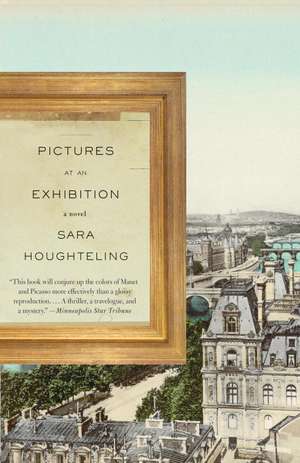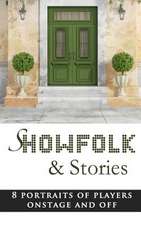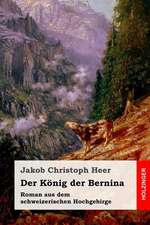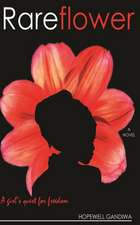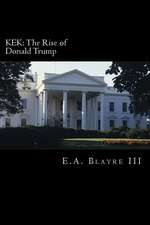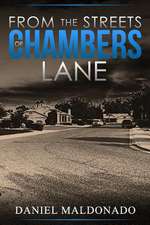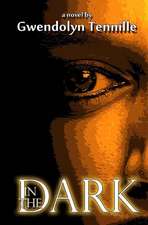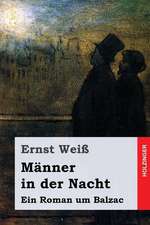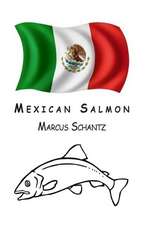Pictures at an Exhibition
Autor Sara Houghtelingen Limba Engleză Paperback – 31 ian 2010
Vezi toate premiile Carte premiată
National Jewish Book Award (2009), Harold U. Ribalow Prize (2010)
Max Berenzon’s father is the most successful art dealer in Paris, owner of the Berenzon Gallery, home to both Picasso and Matisse. To Max’s great surprise, his father forbids him from entering the family business, choosing instead to hire a beautiful and brilliant gallery assistant named Rose Clément. When Paris falls to the Nazis, the Berenzons survive in hiding, but when they return in 1944 their gallery is empty, their priceless collection vanished. In a city darkened by corruption and black martketers, Max chases his twin obsessions: the lost paintings and Rose Clément.
Preț: 103.66 lei
Nou
Puncte Express: 155
Preț estimativ în valută:
19.84€ • 21.54$ • 16.66£
19.84€ • 21.54$ • 16.66£
Carte disponibilă
Livrare economică 01-15 aprilie
Preluare comenzi: 021 569.72.76
Specificații
ISBN-13: 9780307386304
ISBN-10: 0307386309
Pagini: 243
Dimensiuni: 136 x 203 x 20 mm
Greutate: 0.28 kg
Editura: Vintage Books USA
ISBN-10: 0307386309
Pagini: 243
Dimensiuni: 136 x 203 x 20 mm
Greutate: 0.28 kg
Editura: Vintage Books USA
Notă biografică
Sara Houghteling is a graduate of Harvard College and received her master’s in fine arts from the University of Michigan. She is the recipient of a Fulbright scholarship to Paris, first place in the Avery and Jules Hopwood Awards, and a John Steinbeck Fellowship. She lives in California, where she teaches high school English.
Extras
Chapter One
In the twilight of my life, I began to question if my childhood was a time of almost absurd languor, or if the violence that would strike us later had lurked there all along. I revisited certain of these memories, determined to find the hidden vein of savagery within them: the sticky hand, the scattered nuts, the gap- toothed girl grasping a firecracker, a cap floating on the Seine, flayed legs swinging between a pair of crutches, the tailor and his mouthful of pins. Some of these were immediately ominous, while others only later revealed themselves as such. However, whether or not another boy living my life would agree, I cannot say.
Of the humble beginnings from which my father built his fame, I knew only a few details. My grandfather, Abraham Berenzon, born in 1865, had inherited an artists’ supply store. He sold tinctures, oil, canvases, palettes and palette knives, miniver brushes made from squirrel fur, purple- labeled bottles of turpentine, and easels, which my father described as stacked like a pile of bones. The shop was wedged between a cobbler’s and a dressmaker’s. Artists paid in paintings when they could not pay their bills. And as Renoir, Pissarro, and Courbet were far better with paint than with money, the family built up a collection.
When the value of a painting exceeded the price of its paint, Abraham sold it and invested the money with the Count Moïses de Camondo, a Jew from Istanbul with an Italian title and a counting-house that he named the Bank of Constantinople. Both men loved art, and they were fast friends. By 1900, Abraham could purchase an apartment on rue Lafitte, near Notre- Dame-de-Lorette, in a neighborhood known as the Florence of Paris. Soon afterward, Moïses de Camondo recommended that my grandfather invest in the railroads. Coffers opened by the beauty of paint were lined with the spoils of steel, steam, and iron, and my grandfather did not have to sell any more of his paintings.
As a teenager, I often passed by rue Lafitte and imagined the family home as it had once been, as my father had described it: each picture
on the grand salon’s walls opening like a window—onto a wintry landscape, a tilted table with rolling apples, a ballet studio blooming with turquoise tulle. The salon’s chandelier shone onto the street through windows which, as was the case across the Continent, were made from high- quality crystal. On sunny afternoons, Grandfather’s gallery was so ablaze with prismatic light that schoolchildren returning home for lunch thought they saw angels fluttering down rue Lafitte. They reported their sightings to the choirmaster at Notre-Dame-de-Lorette. When he could no longer bear to tell any more youngsters that they had not seen angels but just rainbows, and from a Jew’s house no less, the choirmaster hinted to some older boys that perhaps they should break the windows, which they did.
At least that was how my father explained the attack on his childhood home in July of 1906. Then again, Dreyfus had just been exonerated,
and there were many such outbursts across Paris. Abraham had followed the trial closely, nearly sleepless until the Jewish captain’s verdict was announced. Two days later, hoping to spare a dog that ran into the road, he drove his open- roofed Delage into an arbor of pollarded trees on avenue de Breteuil. My sixteen- year- old father, Daniel, was pinned between the tree trunk and the crushed hood as
Abraham expired beside him. From then on, my father walked with a limp, which eight years later exempted him from service in the Great War. So whether he was lucky or unlucky, I could not exactly say.
In 1917, my father purchased the building at 21, rue de La Boétie, after my mother Eva agreed to marry him. For this young Polish beauty, whom he hardly knew, and who spoke comically stilted French, he bought a house in a neighborhood known for its tolerance of the creative temperament. Yes, as if in anticipation of the utter bleakness that would eventually follow, that block was home not only to my father the collector and my mother the virtuoso pianist, but also to a choreographer renowned for his collaboration with Diaghilev; the Hungarian trumpeter most preferred by European conductors to perform the second of the Brandenburg Concertos; a sculptor known for his works in bronze and his clamorous machines; and, three years later, though without the same fanfare, me.
From the well of my early childhood, only one half- lit event emerges: I am in the forest and a small girl shares a sweet bag of nuts with me. We dance on the mossy floor, and she holds my sticky fist in her own. Until late in my life, I supposed that the little girl in the white dress had been a dream, invented sometime in the crepuscular years before my seventh birthday. I remembered nothing at all before 1927, when Lindbergh landed at Le Bourget, on an airfield lit brighter than day. This absence of memory was natural, I imagined. I had no siblings with whom to compare my experience and was loath to press others into discussing my youth.
Unlike his own father, mine maintained no particular attachments to the paintings that found their way into his possession upon Abraham’s death. Father sold this collection as the first exhibition of the Daniel Berenzon Gallery in the early 1920s. He explained that, at the time, he had been under the influence of the German philosopher Goethe. “Remember the Theory of Colors, Max,” he said, as he paced the gallery. “When you stare steadfastly at an object, and then it is taken away, the spectrum of another color rises to your mind’s eye. This second image now belongs to the mind. The object’s absence or presence is irrelevant. They’re all up here”—he tapped his head—“so why worry about them out there?” He gestured to the carmine and gold gallery walls. “You’ll have a museum of the mind.”
And for him this was true. To hear my father describe the paintings he had sold—which I thought of as lost—was as if their watery images, quivering and illuminated, were projected on the dark walls of the gallery from a slide carousel. These pictures possessed a certain patina—of regret, of time, of absence, of value—which lent my father’s descriptions a deeper beauty than I had been able to see when the paintings hung before me.
Indeed, my father was among a tiny group, the heirs to the patron spirit of Catherine de Médicis and the savoir faire of Duveen or Vollard, whose genius was not in the handling of paint itself, but in the handling of men who painted. They encouraged the artists’ outrageous experiments so that they could paint without fear of financial ruin. They were not just rug merchants and moneymen. They were as devoted as monks to the beauty of their illuminated manuscripts. Or so my father said, in his most rhapsodic moments. And I believed
him.
Pablo Picasso was my father’s most famous artist, and he too came to live on rue de La Boétie, at number 23. When my father passed below on the street, Picasso would stand in the window and hold up canvases for my father’s approval, and approve he always did. Father encouraged the Spaniard’s experiments, understanding that Picasso’s genius resided not in a single style but in his ability to reinvent himself. He was, Father said, our Fountain of Youth. Since Monsieur Picasso’s art would never grow decrepit or stale, neither would Father and neither would their glorious world of paint. Yet Father kept not a single Picasso in our family collection; what hung over our dinner table would likely be sold the next week. Our walls were never bare, nor were they familiar. “We’re trying to give what we have away,” Father said. Though he hardly gave the paintings away, I wondered, sometimes, if he felt that he had.
Beginning in my earliest years, each night before Father locked the doors to the art gallery, I was called downstairs from my bedroom and, with my eyes closed, was told the name of a past exhibition and made to recite each painting’s artist, title, and composition: a Morisot Woman in White looking like an angel with the dress slipping from her shoulder; the Vuillard odalisque NudeHiding Her Face from 1904; an iridescent 1910 Bonnard, Breakfast, of woman, jam, and toast.
After we reviewed the present exhibition, we would recollect past ones, of Sisley and Monet’s winter scenes; Toulouse-Lautrec’s portraits on cardboard with low- grade paint; the occasion on which Father had furnished the exhibition rooms with rococo settees and ormolu chiffoniers and then hung above them the most wild drawings by Braque, Miró, Gris, and Ernst, so as to indicate that modern art could indeed decorate a home. Though Father’s clients purchased mostly for this purpose, privately he scoffed at those who arrived with a scrap of drapery when choosing a painting. “The artist is an aristocrat, Max,” my father told me. “He has suffered for his art. And yet still he is generous, because he offers us a new language that permits us to converse outside of words.”
I often wished that Father would not converse outside of words but, rather, raise other subjects during these meetings and guide me on boyhood matters, such as girls in sweaters or my birthday choice of alpine skis. Once or twice, I sensed that he tried to. I waited patiently, nearly holding my breath so as not to break the spell when Father began, “Over the years, I have wanted to tell you—” But this sentence, though repeated, was never finished, and eventually I gave up hope. Still, the nightly recitations were treasured occasions with my father, a man for whose attention many people, including my mother, had to fight.
In my memory of those nights in the gallery with pictures orbiting around me, my father is splendid, luminous even. He had a brushy mustache, a neat chin, and a slim neck. He wore a white collar and a long tie the shade and sheen of obsidian: a lean, angular man, as if he had stepped out of a canvas by Modigliani and, dusting the paint from his dinner jacket, taken his place against the gallery’s doorjamb. He parted his black hair on the side and his eyebrows looked penciled in. His face might have seemed too small were it not for the significant ears, the plane of his cheekbones, and his long, sloping nose.
As pictures were hoisted to the walls and then lowered, President Doumer was shot dead at a book fair, the Lindbergh son was kidnapped, and America choked in a cloud of dust. All of France seemed to be on strike. By eleven, I was expected to discuss various genres and artists.
“On still lifes,” my father began, and walked to the back of the red divan.
“The lowliest of genres,” I said. “Courbet painted his in prison.”
“Yes.”
“With landscape painting only slightly superior.”
From upstairs, we heard Mother singing along with her piano playing. Sometimes she sang the orchestra parts to Brahms or Beethoven, or hummed along with the piano melody so as not to lose her place in it as her fingers whirled through their steps. If Father was rehearsing the art of recollection with me, we both knew that Mother, with her hundreds of hours of music committed to memory, reigned supreme.
Whatever sensitivity Father and I might have possessed, Mother surpassed this, too: she heard sharps in the opening and closing of my dresser drawers and an unpleasant A-flat when the telephone rang. She thanked Father for choosing an automobile whose motor played an excellent C. When Mother traveled to Zurich and London to perform, I was left in the care of our housekeeper, Lucie, and our chauffeur, Auguste. Both loved music and, fortunately, both loved me.
I grew from a boy in pajamas to a young man who lit his father’s cigarette before smoking his own. The fixed point in Father’s collection was Manet’s Almonds, painted in the years between 1869 and 1871. It was the one painting from my youth that had never left 21, rue de La Boétie, not in the first auction nor in the dozens that would follow. When Father bought Manet’s The Bar at the Folies- Bergère before lunch and sold it by dinnertime to a British sugar magnate, Almonds stayed behind; Picasso’s The Family of Saltimbanques was shipped to New York, but Almonds stayed behind. Even when Mrs. Guggenheim was on her campaign, as she told Father, to buy “a picture a day,” Almonds remained. Father claimed that no one offered him the right price for it, though later I came to understand otherwise. Father loved the painting, though he would not say why, except that it was painted by a humbled man nearing the end of his life, when Manet’s legs were weak with syphilis and the artist could no longer stand at his grand canvases, as he had done with The Execution of Maximilian or The Bar at the Folies- Bergère. The man whose life had begun to still began to paint still lifes. I did not consider Manet’s Almonds beautiful. I found it morbid and sad to look at in the morning hours, when the light was clear and bright. In comparison to Cézanne, who often had to replace his pyramids of apples with wax versions because the real fruit rotted after a fortnight of study, Manet’s almonds were the ones that had been passed over, deemed too inferior to eat, painted by someone who’d had his fill.
When the time came to take my winter exams, Father explained that he could not “with good conscience” pass his beautiful gallery down to me. The day before, there was news of Kristallnacht in Berlin; Mother had said, “surely your courses will be canceled,” but they were not.
For a year, we did not rehearse the paintings. Rather, I rehearsed Father’s sudden rejection: I lacked, he had said, the memory, the business acumen, the ruthlessness, and the lucidity of vision to predict what could be bought one spring and sold a dozen Junes hence. “I wish for you a stable life,” he said. “My father drove too fast.” This I did not hear. I was made to fill out the exams and forms for the schooling that would land me in the hospital, not as a patient like my father long ago, but as a doctor. I resolved to fail as brilliantly as I had once studied to inherit the gallery. Eventually, Father and I resumed our nightly study of the paintings, but it was never the same as before. I was seventeen years old.
From the Hardcover edition.
In the twilight of my life, I began to question if my childhood was a time of almost absurd languor, or if the violence that would strike us later had lurked there all along. I revisited certain of these memories, determined to find the hidden vein of savagery within them: the sticky hand, the scattered nuts, the gap- toothed girl grasping a firecracker, a cap floating on the Seine, flayed legs swinging between a pair of crutches, the tailor and his mouthful of pins. Some of these were immediately ominous, while others only later revealed themselves as such. However, whether or not another boy living my life would agree, I cannot say.
Of the humble beginnings from which my father built his fame, I knew only a few details. My grandfather, Abraham Berenzon, born in 1865, had inherited an artists’ supply store. He sold tinctures, oil, canvases, palettes and palette knives, miniver brushes made from squirrel fur, purple- labeled bottles of turpentine, and easels, which my father described as stacked like a pile of bones. The shop was wedged between a cobbler’s and a dressmaker’s. Artists paid in paintings when they could not pay their bills. And as Renoir, Pissarro, and Courbet were far better with paint than with money, the family built up a collection.
When the value of a painting exceeded the price of its paint, Abraham sold it and invested the money with the Count Moïses de Camondo, a Jew from Istanbul with an Italian title and a counting-house that he named the Bank of Constantinople. Both men loved art, and they were fast friends. By 1900, Abraham could purchase an apartment on rue Lafitte, near Notre- Dame-de-Lorette, in a neighborhood known as the Florence of Paris. Soon afterward, Moïses de Camondo recommended that my grandfather invest in the railroads. Coffers opened by the beauty of paint were lined with the spoils of steel, steam, and iron, and my grandfather did not have to sell any more of his paintings.
As a teenager, I often passed by rue Lafitte and imagined the family home as it had once been, as my father had described it: each picture
on the grand salon’s walls opening like a window—onto a wintry landscape, a tilted table with rolling apples, a ballet studio blooming with turquoise tulle. The salon’s chandelier shone onto the street through windows which, as was the case across the Continent, were made from high- quality crystal. On sunny afternoons, Grandfather’s gallery was so ablaze with prismatic light that schoolchildren returning home for lunch thought they saw angels fluttering down rue Lafitte. They reported their sightings to the choirmaster at Notre-Dame-de-Lorette. When he could no longer bear to tell any more youngsters that they had not seen angels but just rainbows, and from a Jew’s house no less, the choirmaster hinted to some older boys that perhaps they should break the windows, which they did.
At least that was how my father explained the attack on his childhood home in July of 1906. Then again, Dreyfus had just been exonerated,
and there were many such outbursts across Paris. Abraham had followed the trial closely, nearly sleepless until the Jewish captain’s verdict was announced. Two days later, hoping to spare a dog that ran into the road, he drove his open- roofed Delage into an arbor of pollarded trees on avenue de Breteuil. My sixteen- year- old father, Daniel, was pinned between the tree trunk and the crushed hood as
Abraham expired beside him. From then on, my father walked with a limp, which eight years later exempted him from service in the Great War. So whether he was lucky or unlucky, I could not exactly say.
In 1917, my father purchased the building at 21, rue de La Boétie, after my mother Eva agreed to marry him. For this young Polish beauty, whom he hardly knew, and who spoke comically stilted French, he bought a house in a neighborhood known for its tolerance of the creative temperament. Yes, as if in anticipation of the utter bleakness that would eventually follow, that block was home not only to my father the collector and my mother the virtuoso pianist, but also to a choreographer renowned for his collaboration with Diaghilev; the Hungarian trumpeter most preferred by European conductors to perform the second of the Brandenburg Concertos; a sculptor known for his works in bronze and his clamorous machines; and, three years later, though without the same fanfare, me.
From the well of my early childhood, only one half- lit event emerges: I am in the forest and a small girl shares a sweet bag of nuts with me. We dance on the mossy floor, and she holds my sticky fist in her own. Until late in my life, I supposed that the little girl in the white dress had been a dream, invented sometime in the crepuscular years before my seventh birthday. I remembered nothing at all before 1927, when Lindbergh landed at Le Bourget, on an airfield lit brighter than day. This absence of memory was natural, I imagined. I had no siblings with whom to compare my experience and was loath to press others into discussing my youth.
Unlike his own father, mine maintained no particular attachments to the paintings that found their way into his possession upon Abraham’s death. Father sold this collection as the first exhibition of the Daniel Berenzon Gallery in the early 1920s. He explained that, at the time, he had been under the influence of the German philosopher Goethe. “Remember the Theory of Colors, Max,” he said, as he paced the gallery. “When you stare steadfastly at an object, and then it is taken away, the spectrum of another color rises to your mind’s eye. This second image now belongs to the mind. The object’s absence or presence is irrelevant. They’re all up here”—he tapped his head—“so why worry about them out there?” He gestured to the carmine and gold gallery walls. “You’ll have a museum of the mind.”
And for him this was true. To hear my father describe the paintings he had sold—which I thought of as lost—was as if their watery images, quivering and illuminated, were projected on the dark walls of the gallery from a slide carousel. These pictures possessed a certain patina—of regret, of time, of absence, of value—which lent my father’s descriptions a deeper beauty than I had been able to see when the paintings hung before me.
Indeed, my father was among a tiny group, the heirs to the patron spirit of Catherine de Médicis and the savoir faire of Duveen or Vollard, whose genius was not in the handling of paint itself, but in the handling of men who painted. They encouraged the artists’ outrageous experiments so that they could paint without fear of financial ruin. They were not just rug merchants and moneymen. They were as devoted as monks to the beauty of their illuminated manuscripts. Or so my father said, in his most rhapsodic moments. And I believed
him.
Pablo Picasso was my father’s most famous artist, and he too came to live on rue de La Boétie, at number 23. When my father passed below on the street, Picasso would stand in the window and hold up canvases for my father’s approval, and approve he always did. Father encouraged the Spaniard’s experiments, understanding that Picasso’s genius resided not in a single style but in his ability to reinvent himself. He was, Father said, our Fountain of Youth. Since Monsieur Picasso’s art would never grow decrepit or stale, neither would Father and neither would their glorious world of paint. Yet Father kept not a single Picasso in our family collection; what hung over our dinner table would likely be sold the next week. Our walls were never bare, nor were they familiar. “We’re trying to give what we have away,” Father said. Though he hardly gave the paintings away, I wondered, sometimes, if he felt that he had.
Beginning in my earliest years, each night before Father locked the doors to the art gallery, I was called downstairs from my bedroom and, with my eyes closed, was told the name of a past exhibition and made to recite each painting’s artist, title, and composition: a Morisot Woman in White looking like an angel with the dress slipping from her shoulder; the Vuillard odalisque NudeHiding Her Face from 1904; an iridescent 1910 Bonnard, Breakfast, of woman, jam, and toast.
After we reviewed the present exhibition, we would recollect past ones, of Sisley and Monet’s winter scenes; Toulouse-Lautrec’s portraits on cardboard with low- grade paint; the occasion on which Father had furnished the exhibition rooms with rococo settees and ormolu chiffoniers and then hung above them the most wild drawings by Braque, Miró, Gris, and Ernst, so as to indicate that modern art could indeed decorate a home. Though Father’s clients purchased mostly for this purpose, privately he scoffed at those who arrived with a scrap of drapery when choosing a painting. “The artist is an aristocrat, Max,” my father told me. “He has suffered for his art. And yet still he is generous, because he offers us a new language that permits us to converse outside of words.”
I often wished that Father would not converse outside of words but, rather, raise other subjects during these meetings and guide me on boyhood matters, such as girls in sweaters or my birthday choice of alpine skis. Once or twice, I sensed that he tried to. I waited patiently, nearly holding my breath so as not to break the spell when Father began, “Over the years, I have wanted to tell you—” But this sentence, though repeated, was never finished, and eventually I gave up hope. Still, the nightly recitations were treasured occasions with my father, a man for whose attention many people, including my mother, had to fight.
In my memory of those nights in the gallery with pictures orbiting around me, my father is splendid, luminous even. He had a brushy mustache, a neat chin, and a slim neck. He wore a white collar and a long tie the shade and sheen of obsidian: a lean, angular man, as if he had stepped out of a canvas by Modigliani and, dusting the paint from his dinner jacket, taken his place against the gallery’s doorjamb. He parted his black hair on the side and his eyebrows looked penciled in. His face might have seemed too small were it not for the significant ears, the plane of his cheekbones, and his long, sloping nose.
As pictures were hoisted to the walls and then lowered, President Doumer was shot dead at a book fair, the Lindbergh son was kidnapped, and America choked in a cloud of dust. All of France seemed to be on strike. By eleven, I was expected to discuss various genres and artists.
“On still lifes,” my father began, and walked to the back of the red divan.
“The lowliest of genres,” I said. “Courbet painted his in prison.”
“Yes.”
“With landscape painting only slightly superior.”
From upstairs, we heard Mother singing along with her piano playing. Sometimes she sang the orchestra parts to Brahms or Beethoven, or hummed along with the piano melody so as not to lose her place in it as her fingers whirled through their steps. If Father was rehearsing the art of recollection with me, we both knew that Mother, with her hundreds of hours of music committed to memory, reigned supreme.
Whatever sensitivity Father and I might have possessed, Mother surpassed this, too: she heard sharps in the opening and closing of my dresser drawers and an unpleasant A-flat when the telephone rang. She thanked Father for choosing an automobile whose motor played an excellent C. When Mother traveled to Zurich and London to perform, I was left in the care of our housekeeper, Lucie, and our chauffeur, Auguste. Both loved music and, fortunately, both loved me.
I grew from a boy in pajamas to a young man who lit his father’s cigarette before smoking his own. The fixed point in Father’s collection was Manet’s Almonds, painted in the years between 1869 and 1871. It was the one painting from my youth that had never left 21, rue de La Boétie, not in the first auction nor in the dozens that would follow. When Father bought Manet’s The Bar at the Folies- Bergère before lunch and sold it by dinnertime to a British sugar magnate, Almonds stayed behind; Picasso’s The Family of Saltimbanques was shipped to New York, but Almonds stayed behind. Even when Mrs. Guggenheim was on her campaign, as she told Father, to buy “a picture a day,” Almonds remained. Father claimed that no one offered him the right price for it, though later I came to understand otherwise. Father loved the painting, though he would not say why, except that it was painted by a humbled man nearing the end of his life, when Manet’s legs were weak with syphilis and the artist could no longer stand at his grand canvases, as he had done with The Execution of Maximilian or The Bar at the Folies- Bergère. The man whose life had begun to still began to paint still lifes. I did not consider Manet’s Almonds beautiful. I found it morbid and sad to look at in the morning hours, when the light was clear and bright. In comparison to Cézanne, who often had to replace his pyramids of apples with wax versions because the real fruit rotted after a fortnight of study, Manet’s almonds were the ones that had been passed over, deemed too inferior to eat, painted by someone who’d had his fill.
When the time came to take my winter exams, Father explained that he could not “with good conscience” pass his beautiful gallery down to me. The day before, there was news of Kristallnacht in Berlin; Mother had said, “surely your courses will be canceled,” but they were not.
For a year, we did not rehearse the paintings. Rather, I rehearsed Father’s sudden rejection: I lacked, he had said, the memory, the business acumen, the ruthlessness, and the lucidity of vision to predict what could be bought one spring and sold a dozen Junes hence. “I wish for you a stable life,” he said. “My father drove too fast.” This I did not hear. I was made to fill out the exams and forms for the schooling that would land me in the hospital, not as a patient like my father long ago, but as a doctor. I resolved to fail as brilliantly as I had once studied to inherit the gallery. Eventually, Father and I resumed our nightly study of the paintings, but it was never the same as before. I was seventeen years old.
From the Hardcover edition.
Recenzii
“[A] captivating first novel…. At once crisp and poetic, detailed and spare.” --The New York Times Book Review
“Graceful, persuasive…. The details—whether the contents of Matisse’s studio, or the packing and transporting of ‘Winged Victory’ from the Louvre in 1940—ring true…. Houghteling is a writer to watch.” —Milwaukee Journal-Sentinel
“[A] lean, atmospheric novel…. Paris, even under the Germans, is storybook wonderful, and an unending display of great art marches through these pages.” —Dallas Morning News
“Evok[es] the atmosphere of Paris in the 1930s and ‘40s, using that mixture of the historical and the fictional that Alan Furst has made his metier. . . . Pictures at an Exhibition is an entertaining read and a window into a period in the history of the art market that was quickly denied.” —San Francisco Chronicle
“Intelligent. . . . [Houghteling] does an excellent job of portraying the varying degrees of complicity of Paris’s remaining art dealers and leads a reader with a sure hand through a closed and rarified world.” —The Christian Science Monitor
“More than most writers, Houghteling succeeds in making us feel and understand the full, perverse impact of the German pillage of art in World War II, its sickening human cost.” —The Washington Post Book World
“A timely and touching first novel set in the World War II Paris art world that will appeal to all art lovers and especially to those addicted to following the vagaries of Nazi loot.” —Lynn H. Nicholas, author of The Rape of Europa
“Pictures at an Exhibition . . . offers a free trip to Paris. . . . This is the Paris of Impressionist paintings and 18th-century apartments, the Paris of classical music floating out of bay windows at 4 a.m. while young swains buy pretty girls daffodils from pushcarts on Les Halles. This is the Paris of balusters and brocade, marbled light and Maurice Chevalier, the Paris of cobblestone alleys and bustling boulevards, opinionated greengrocers and passionate lovers.” —Minneapolis Star-Tribune
“This powerful first novel sets the historical tragedy [of Nazi looting] against a sad yet compelling tale of love and loss. The characters, all in their own ways emotionally wounded, seem as real as our neighbors. Marvelous little asides about art are scattered throughout the story, but what most struck me was the power of the prose. . . . Masterful.” —Stephen L. Carter, The Daily Beast
“Haunting. . . . With amazing authenticity, the author tells [her characters’] stories with all the twists and turns of the very best fiction.” —The Free Lance-Star
“[Pictures at an Exhibition] is more than just a love story and a description of Nazi greed. It is a metaphysical narrative that delves into themes of friendships and family relationships.” —San Antonio Express-News
“What a beautiful book! Sara Houghteling’s theme here is attachment: to the beauty of art, to childhood, to a world before loss and tragedy. The Paris she conjures for us is vivid and sad, the paintings she describes are glorious.” —Sophie Gee, author of The Scandal of the Season
“Houghteling’s knowledge of the inner workings of the early to mid-century art market—clearly the product of prodigious research—serves her well. . . . An engaging tale of familial love and redemption told through a search for artworks that are ultimately surrogates: The thousands of missing paintings stand in for the millions of people who perished in the camps.” —The New Leader
“Pictures at an Exhibition has the fine-grained feeling of photographs by Kertesz or Atget. . . . Sparkling. . . . Houghteling writes with a spare grace, every scene supple and brisk, on this dark odyssey through a spiritually dimmed city.” —The Weekly Standard
“Pictures at an Exhibition is remarkably self-assured, astute, worldly, and well-informed; in fact, it does not look like a first novel at all. Its subject-matter–stolen paintings, and Nazis, and the insatiable hunger for beauty–requires both erudition and brilliance, and Sara Houghteling has plenty of both, along with a sense of humor and a warm heart.” —Charles Baxter, author of The Soul Thief
“Moves with fluid grace between the real and the un, between bureaucratic and poetic. . . . Houghteling’s love of her subject is unmistakable. ”—Time Out Chicago
“Shows the socioeconomic and cultural diversity of mid-century Paris quite well. . . . A skillful work.” —Chattanooga Free Press
“Engrossing reading. Miss Houghteling has done her research well, and her descriptions of real paintings and places have depth and beauty.” —The Washington Times
“An impressive debut . . . Pictures at an Exhibition is both well-prepared and well-written, it grabs you and drags you along as it creeps through shady backalleys looking for black-market art dealers, and it stuns you just as it stuns Max Berenzon when some disturbing revelations are made.” —Sacramento Book Review
“Compelling and important.” —The Jerusalem Post
“Remarkable. . . . A refreshingly understated work that offers a subtle but powerful exploration of loss, and of the pain and havoc left in its wake.” —Haaretz
“In times like this, one turns to books like Pictures at an Exhibition for their exhilarating sense of wonder and ambition. No other book I have read in a long time has such depth of history and intelligence, setting art as antidote for suffering, and love as both a cause and remedy for pain.” —Andrew Sean Greer, author of The Story of a Marriage and The Confessions of Max Tivoli
“In Pictures at an Exhibition, Sara Houghteling breathes new life into one of history’s great, unfinished stories. As exquisitely detailed and lavishly sensuous as the paintings that populate its pages, this is a riveting debut.” —Dustin Thomason, co-author of The Rule of Four
“Graceful, persuasive…. The details—whether the contents of Matisse’s studio, or the packing and transporting of ‘Winged Victory’ from the Louvre in 1940—ring true…. Houghteling is a writer to watch.” —Milwaukee Journal-Sentinel
“[A] lean, atmospheric novel…. Paris, even under the Germans, is storybook wonderful, and an unending display of great art marches through these pages.” —Dallas Morning News
“Evok[es] the atmosphere of Paris in the 1930s and ‘40s, using that mixture of the historical and the fictional that Alan Furst has made his metier. . . . Pictures at an Exhibition is an entertaining read and a window into a period in the history of the art market that was quickly denied.” —San Francisco Chronicle
“Intelligent. . . . [Houghteling] does an excellent job of portraying the varying degrees of complicity of Paris’s remaining art dealers and leads a reader with a sure hand through a closed and rarified world.” —The Christian Science Monitor
“More than most writers, Houghteling succeeds in making us feel and understand the full, perverse impact of the German pillage of art in World War II, its sickening human cost.” —The Washington Post Book World
“A timely and touching first novel set in the World War II Paris art world that will appeal to all art lovers and especially to those addicted to following the vagaries of Nazi loot.” —Lynn H. Nicholas, author of The Rape of Europa
“Pictures at an Exhibition . . . offers a free trip to Paris. . . . This is the Paris of Impressionist paintings and 18th-century apartments, the Paris of classical music floating out of bay windows at 4 a.m. while young swains buy pretty girls daffodils from pushcarts on Les Halles. This is the Paris of balusters and brocade, marbled light and Maurice Chevalier, the Paris of cobblestone alleys and bustling boulevards, opinionated greengrocers and passionate lovers.” —Minneapolis Star-Tribune
“This powerful first novel sets the historical tragedy [of Nazi looting] against a sad yet compelling tale of love and loss. The characters, all in their own ways emotionally wounded, seem as real as our neighbors. Marvelous little asides about art are scattered throughout the story, but what most struck me was the power of the prose. . . . Masterful.” —Stephen L. Carter, The Daily Beast
“Haunting. . . . With amazing authenticity, the author tells [her characters’] stories with all the twists and turns of the very best fiction.” —The Free Lance-Star
“[Pictures at an Exhibition] is more than just a love story and a description of Nazi greed. It is a metaphysical narrative that delves into themes of friendships and family relationships.” —San Antonio Express-News
“What a beautiful book! Sara Houghteling’s theme here is attachment: to the beauty of art, to childhood, to a world before loss and tragedy. The Paris she conjures for us is vivid and sad, the paintings she describes are glorious.” —Sophie Gee, author of The Scandal of the Season
“Houghteling’s knowledge of the inner workings of the early to mid-century art market—clearly the product of prodigious research—serves her well. . . . An engaging tale of familial love and redemption told through a search for artworks that are ultimately surrogates: The thousands of missing paintings stand in for the millions of people who perished in the camps.” —The New Leader
“Pictures at an Exhibition has the fine-grained feeling of photographs by Kertesz or Atget. . . . Sparkling. . . . Houghteling writes with a spare grace, every scene supple and brisk, on this dark odyssey through a spiritually dimmed city.” —The Weekly Standard
“Pictures at an Exhibition is remarkably self-assured, astute, worldly, and well-informed; in fact, it does not look like a first novel at all. Its subject-matter–stolen paintings, and Nazis, and the insatiable hunger for beauty–requires both erudition and brilliance, and Sara Houghteling has plenty of both, along with a sense of humor and a warm heart.” —Charles Baxter, author of The Soul Thief
“Moves with fluid grace between the real and the un, between bureaucratic and poetic. . . . Houghteling’s love of her subject is unmistakable. ”—Time Out Chicago
“Shows the socioeconomic and cultural diversity of mid-century Paris quite well. . . . A skillful work.” —Chattanooga Free Press
“Engrossing reading. Miss Houghteling has done her research well, and her descriptions of real paintings and places have depth and beauty.” —The Washington Times
“An impressive debut . . . Pictures at an Exhibition is both well-prepared and well-written, it grabs you and drags you along as it creeps through shady backalleys looking for black-market art dealers, and it stuns you just as it stuns Max Berenzon when some disturbing revelations are made.” —Sacramento Book Review
“Compelling and important.” —The Jerusalem Post
“Remarkable. . . . A refreshingly understated work that offers a subtle but powerful exploration of loss, and of the pain and havoc left in its wake.” —Haaretz
“In times like this, one turns to books like Pictures at an Exhibition for their exhilarating sense of wonder and ambition. No other book I have read in a long time has such depth of history and intelligence, setting art as antidote for suffering, and love as both a cause and remedy for pain.” —Andrew Sean Greer, author of The Story of a Marriage and The Confessions of Max Tivoli
“In Pictures at an Exhibition, Sara Houghteling breathes new life into one of history’s great, unfinished stories. As exquisitely detailed and lavishly sensuous as the paintings that populate its pages, this is a riveting debut.” —Dustin Thomason, co-author of The Rule of Four
Descriere
Set in a Paris darkened by World War II, Houghteling's sweeping and sensuous debut novel tells the story of a son's quest to recover his family's lost masterpieces, looted by the Nazis during the occupation.
Premii
- National Jewish Book Award Finalist, 2009
- Harold U. Ribalow Prize Winner, 2010
